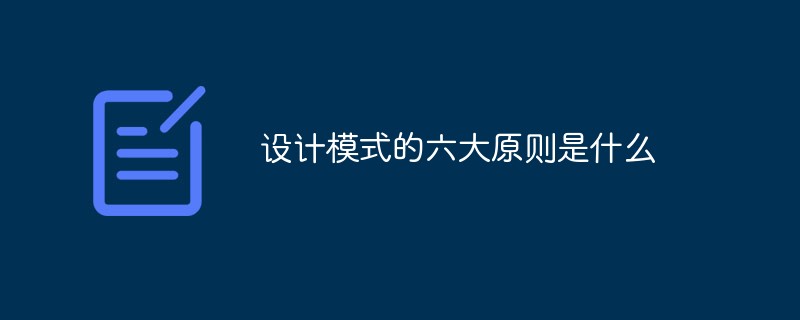PHP is a commonly used server-side programming language that is widely used, especially in the field of web development. Due to the large number of website visits and large amounts of data, performance problems on PHP websites are relatively common, so the caching mechanism is an essential part. In PHP, there are some commonly used caching design patterns, and this article will introduce them.
1. Page caching mode
Page caching refers to caching page content into memory or disk to avoid fetching data from the database and rendering the page with each request. Page caching can be static or dynamic. Static page caching is usually used when page information is not updated frequently, such as the homepage of a website. Dynamic page caching generates a cache file based on the requested parameters. If the parameters of the next request are the same, the cache file is directly read and the results are returned, avoiding a large amount of CPU and database resource consumption.
2. Object caching mode
Object caching is to cache PHP objects in memory or disk to avoid having to re-create them every time and can be shared across requests. When implementing object caching, you usually need to use some caching libraries, such as Memcached cache, Redis cache, etc.
3. Query cache mode
Query cache mode refers to caching database query results into memory or disk to avoid re-querying the database every time. Query caching generally requires the use of some cache libraries, such as memcached cache, redis cache, APC cache, etc.
4. Fragment caching mode
Fragment caching refers to caching a certain part of the page, such as a certain list, an advertising space, etc., to avoid having to regenerate it every time. The difference between fragment caching and page caching is that page caching caches the entire page, while fragment caching only caches part of the content.
5. CDN Caching Mode
Content Delivery Network (CDN) refers to a network composed of multiple servers, located in multiple cities or even multiple countries. Its purpose is to Website static content (such as js, css, pictures, etc.) is cached on CDN nodes around the world to speed up user access. Using CDN caching can greatly reduce network transmission time and improve website performance.
6. Front-end caching mode
Front-end caching refers to caching static resource files, such as CSS, JS, images, etc., into the browser. When the user visits again, they can read them directly from the browser cache. fetch instead of sending a request to the server. Front-end caching can be implemented using technologies such as ETag and Last-Modified.
In PHP, the above caching design patterns are widely used. In actual development, it is necessary to choose the appropriate caching mode according to different situations and implement it in combination with some caching libraries. Caching can not only improve the performance of the website, but also reduce the burden on the server and improve the reliability and stability of the application.
The above is the detailed content of Common caching design patterns in PHP. For more information, please follow other related articles on the PHP Chinese website!
 如何在PHP后端功能开发中合理应用设计模式?Aug 07, 2023 am 10:34 AM
如何在PHP后端功能开发中合理应用设计模式?Aug 07, 2023 am 10:34 AM如何在PHP后端功能开发中合理应用设计模式?设计模式是一种经过实践证明的解决特定问题的方案模板,可以用于构建可复用的代码,在开发过程中提高可维护性和可扩展性。在PHP后端功能开发中,合理应用设计模式可以帮助我们更好地组织和管理代码,提高代码质量和开发效率。本文将介绍常用的设计模式,并给出相应的PHP代码示例。单例模式(Singleton)单例模式适用于需要保
 如何通过编写代码来学习和运用 PHP8 的设计模式Sep 12, 2023 pm 02:42 PM
如何通过编写代码来学习和运用 PHP8 的设计模式Sep 12, 2023 pm 02:42 PM如何通过编写代码来学习和运用PHP8的设计模式设计模式是软件开发中常用的解决问题的方法论,它可以提高代码的可扩展性、可维护性和重用性。而PHP8作为最新版的PHP语言,也引入了许多新特性和改进,提供更多的工具和功能来支持设计模式的实现。本文将介绍一些常见的设计模式,并通过编写代码来演示在PHP8中如何运用这些设计模式。让我们开始吧!一、单例模式(Sing
 深入聊聊设计模式利器之“职责链模式”(附go实现流程)Jan 17, 2023 am 11:43 AM
深入聊聊设计模式利器之“职责链模式”(附go实现流程)Jan 17, 2023 am 11:43 AM本篇文章给大家带来了关于golang设计模式的相关知识,其中主要介绍了职责链模式是什么及其作用价值,还有职责链Go代码的具体实现方法,下面一起来看一下,希望对需要的朋友有所帮助。
 Go语言中的ETL的设计模式Jun 01, 2023 pm 09:01 PM
Go语言中的ETL的设计模式Jun 01, 2023 pm 09:01 PM随着数据的增长和复杂性的不断提升,ETL(Extract、Transform、Load)已成为数据处理中的重要环节。而Go语言作为一门高效、轻量的编程语言,越来越受到人们的热捧。本文将介绍Go语言中常用的ETL设计模式,以帮助读者更好地进行数据处理。一、Extractor设计模式Extractor是指从源数据中提取数据的组件,常见的有文件读取、数据库读取、A
 深入解析Go语言中的单例模式Mar 21, 2023 pm 06:36 PM
深入解析Go语言中的单例模式Mar 21, 2023 pm 06:36 PM单例模式是一种常见的设计模式,它在系统中仅允许创建一个实例来控制对某些资源的访问。在 Go 语言中,实现单例模式有多种方式,本篇文章将带你深入掌握 Go 语言中的单例模式实现。
 设计模式的六大原则是什么Jan 06, 2023 pm 04:25 PM
设计模式的六大原则是什么Jan 06, 2023 pm 04:25 PM设计模式的六大原则:1、单一职责原则,其核心就是控制类的粒度大小、将对象解耦、提高其内聚性;2、开闭原则,可以通过“抽象约束、封装变化”来实现;3、里氏替换原则,主要阐述了有关继承的一些原则;4、依赖倒置原则,降低了客户与实现模块之间的耦合;5、接口隔离原则,是为了约束接口、降低类对接口的依赖性;6、迪米特法则,要求限制软件实体之间通信的宽度和深度。
 了解JavaScript中的设计模式和最佳实践Nov 03, 2023 am 08:58 AM
了解JavaScript中的设计模式和最佳实践Nov 03, 2023 am 08:58 AM随着JavaScript的不断发展和应用范围的扩大,越来越多的开发人员开始意识到设计模式和最佳实践的重要性。设计模式是一种被证明在某些情况下有用的软件设计解决方案。而最佳实践则是指在编程过程中,我们可以应用的一些最佳的规范和方法。在本文中,我们将探讨JavaScript中的设计模式和最佳实践,并提供一些具体的代码示例。让我们开始吧!一、JavaScript中
 C#开发建议:设计模式与架构选择Nov 22, 2023 pm 03:53 PM
C#开发建议:设计模式与架构选择Nov 22, 2023 pm 03:53 PM在C#开发中,设计模式和架构选择是至关重要的。良好的设计模式和合适的架构选择可以大大提高软件的可维护性、扩展性和性能。本文将讨论一些在C#开发中常用的设计模式和架构选择,并给出一些建议。设计模式是解决特定问题的通用解决方案,它们可以帮助开发人员避免重复造轮子,提高代码的可重用性和可读性。在C#开发中,有许多常用的设计模式,如单例模式、工厂模式、观察者模式等。


Hot AI Tools

Undresser.AI Undress
AI-powered app for creating realistic nude photos

AI Clothes Remover
Online AI tool for removing clothes from photos.

Undress AI Tool
Undress images for free

Clothoff.io
AI clothes remover

AI Hentai Generator
Generate AI Hentai for free.

Hot Article

Hot Tools

mPDF
mPDF is a PHP library that can generate PDF files from UTF-8 encoded HTML. The original author, Ian Back, wrote mPDF to output PDF files "on the fly" from his website and handle different languages. It is slower than original scripts like HTML2FPDF and produces larger files when using Unicode fonts, but supports CSS styles etc. and has a lot of enhancements. Supports almost all languages, including RTL (Arabic and Hebrew) and CJK (Chinese, Japanese and Korean). Supports nested block-level elements (such as P, DIV),

SublimeText3 Linux new version
SublimeText3 Linux latest version

Notepad++7.3.1
Easy-to-use and free code editor

PhpStorm Mac version
The latest (2018.2.1) professional PHP integrated development tool

Dreamweaver CS6
Visual web development tools






